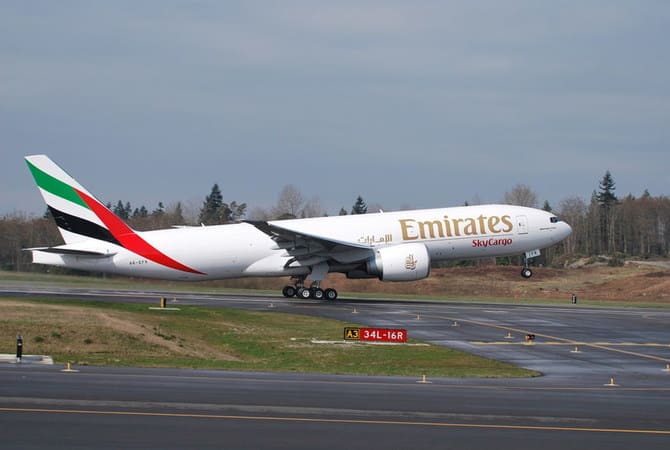Aerospace
Why Greece sent a fighter jet to escort an Emirates flight
Greece sent an F16 fighter jet to escort an Emirates flight while on high alert.

A security alert forced an Emirates flight from Greece to New York to return to Athens International Airport, but Greece found nothing suspicious on board, according to police on Thursday.
After Greek officials received information from American authorities about a “suspicious” passenger, the plane, which was being escorted by two fighter jets, returned to the Eleftherios Venizelos airport in Athens shortly after 2000 GMT for security checks, according to police sources.
Greece proceeds with purchase of 20 Lockheed F-35 fighter jets(Opens in a new browser tab)
Police claim that a request for information led to the jet being told to return to Athens, but after searching the passengers and the plane, they were unable to find the person the information was about or any other suspicious behavior.
On Thursday, permission to leave Eleftherios Venizelos was denied to an earlier Emirates flight bound for Dubai. According to police sources, every passenger underwent a thorough security check as well, but nothing strange was found.
The 10 longest routes in the world flown by airlines, ranked by distance(Opens in a new browser tab)
Police assert that after receiving a request for information, the jet was instructed to return to Athens. However, after examining the passengers and the aircraft, they were unable to locate the person for whom the information was requested or any other suspicious activity.
Air New Zealand connects Auckland and New York for the first time ever(Opens in a new browser tab)
An earlier Emirates flight headed for Dubai was denied clearance to depart Eleftherios Venizelos on Thursday. Every passenger reportedly got a comprehensive security check as well, but nothing unusual was discovered, according to police sources.

Aerospace
Boeing Transfers Rocket Stage to NASA, Paving Way for Human Moon Mission

Boeing has achieved a significant milestone by providing NASA with the second core stage of the Space Launch System (SLS) rocket.
This crucial component, crafted at NASA’s Michoud Assembly Facility (MAF), is set to propel the Artemis II crew into lunar orbit, marking humanity’s return to deep space after a 50-year hiatus.
The monumental Boeing-built rocket stage, the largest element of the Artemis II mission, will embark on a journey aboard the Pegasus barge, traveling 900 miles to NASA’s Kennedy Space Center.
Comparison of two legendary aircraft B777x vs B747 aircraft:Click here
Upon arrival, it will be meticulously integrated with other essential Artemis II components, including the upper stage, solid rocket boosters, and NASA’s Orion spacecraft within the iconic Vehicle Assembly Building. This intricate integration process is a vital step toward the eagerly anticipated Artemis II launch, slated for 2025.
“Boeing-built products helped land humankind on the moon in 1969, and we’re proud to continue that legacy through the Artemis generation,” remarked Dave Dutcher, vice president and program manager for Boeing’s SLS program. “Together, with NASA and our industry partners and suppliers, we are building the world’s most capable rocket and paving the way to deep space through America’s rocket factory in New Orleans.”
NASA, Lockheed Martin Reveal X-59 Quiet Supersonic Aircraft:Click here
The delivery of Core Stage 2 marks a significant achievement in the evolution of the SLS rocket. Towering over 200 feet and powered by four RS-25 engines, this core stage, coupled with two solid-fueled booster rockets, will generate a staggering 8.8 million pounds of thrust. This immense power is crucial to launching Artemis II and future missions into the vast expanse of space.
The SLS rocket stands unparalleled in its capability to transport both crew and substantial cargo to the moon and beyond in a single launch. Its extraordinary capacity will facilitate the delivery of human-rated spacecraft, habitats, and scientific missions to destinations including the moon and Mars, ushering in a new era of space exploration.
-

 Travel1 week ago
Travel1 week agoAir India to Expand US Operations with Three New Routes After a Decade
-

 Travel2 weeks ago
Travel2 weeks agoWhy We Should Avoid These Stamps in a Passport
-

 Airlines1 month ago
Airlines1 month agoInvestigations Reveal Fake Chinese Titanium in Boeing and Airbus Jets
-

 Tech4 weeks ago
Tech4 weeks agoChina’s CATL Plans 1,800-Mile Electric Plane Launch by 2027
-

 Airport3 days ago
Airport3 days agoTop 10 Largest Airports in the World by Size
-

 Aerospace4 weeks ago
Aerospace4 weeks agoChina’s Fighter Jets Turn Wings into Autonomous Drones
-

 Airlines4 days ago
Airlines4 days agoAir India Rolls Out A350s for Delhi-New York JFK and Newark Routes
-

 Defence3 weeks ago
Defence3 weeks agoBoeing Enhances Chinook with New Engines and Block II Upgrades at $96 Million







